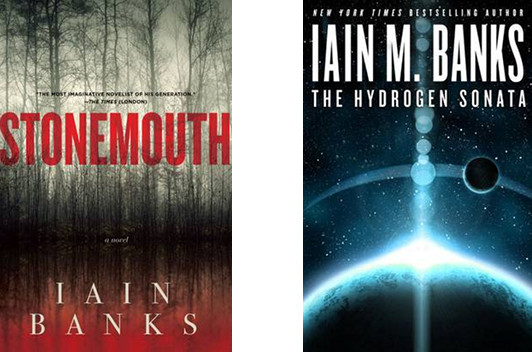Read This: New Books by Iain (M.) Banks

Back in late October, just before Hurricane Sandy hit New York City and my cable/phone/internet service went out for nearly a week (although it’s unclear to me whether the one really brought about the other, but that’s another story), the Dallas Morning News ran my review of two new books by Iain Banks—or, rather, one new novel by Iain Banks and one new novel by Iain M. Banks. For 25 years, you see, Banks has used his middle initial to distinguish his explicit science fiction from his more “literary” efforts…which, in fact, often have genre elements of their own.
Stonemouth, for example, is a downbeat thriller about a young man returning to his Scottish hometown, five years after he’d fled to escape the wrath of a local crime lord whose daughter he’d just cheated on with another girl. An uneasy truce allows Stu to come back for a funeral, but you know how it is with uneasy truces… In the review, I compared Stu’s long weekend to the structure of a Raymond Chandler story, “like Philip Marlowe,” I said, “Stu pokes at unanswered questions about the past and stirs up hints of an even more disturbing family drama, provoking increasingly violent reactions as he goes.”
The Iain M. Banks novel, The Hydrogen Sonata, is pure space opera, the latest installment in a series of stories set in “the Culture,” a world where intelligent spaceships confer with each other to solve a disturbing intergalactic conundrum involving a 10,000-year-old mystery about an entire civilization’s origins, which may well have been the outcome of a practical joke. It’s the literary equivalent of a smart action film with a wicked sense of humor: I explicitly invoked Douglas Adams, while nothing that “Banks modulates the wry humor through a broader emotional palette that includes political intrigues and sweeping action sequences to rival James Cameron.”
There’s usually a significant gap between new Banks books, but it just happened to work out that two American publishers each had a novel of his lined up for this fall season. Stonemouth and The Hydrogen Sonata are quite different in scope, but there’s a common psychological ground that makes me feel very comfortable recommending them both—even to readers who “don’t like science fiction.” Banks’s most alien characters are still recognizably human in their behavior, and he has a knack for picking out the strangenesses of the contemporary world. As it happens, I’ve read more Iain Banks than Iain M. Banks to date, but I’m definitely looking to redress that imbalance in the future.
28 November 2012 | read this |
Read This: Sumo

Thien Pham
Back in 2011, when I reviewed Level Up for Tor.com, I made a note to keep an eye on Thien Pham; after the fantastic job he’d done illustrating Gene Luen Yang’s story, I was eager to see what he’d come up with next. All I knew is that his first work as a writer/artist was going to be a graphic novel called Sumo. Well, now it’s out, and it’s as excellent as I’d hoped for.
Sumo is the story of Scott, a young American who’s come to Japan to train as a sumo wrestler and has hit a significant turning point in his career: If he doesn’t win his next bout, he’ll pretty much have gotten about as far as he’s going to get. He’s got the body and the spirit, his trainer says, but he’s still second-guessing himself—and that might be his downfall.
The artwork is deceptively simple. Pham utilizes a 2×3 grid throughout the graphic novel, occasionally deploying a “widescreen” panel, and within this structure his line is as basic as it was in Level Up, but it’s become tighter, more angular, and the color palette has become starker. The main storyline is tinted a reddish-orange, and Pham weaves in two flashback tracks, green and blue, that tell us about what brought Scott to Japan and his early efforts to adjust to a new life in a strange country.
I’m still in awe of the expressive range that Pham achieves with just a few lines (and dots for eyes), and his cinematic storytelling sense here is fantastic. Sumo has a real flair for honing in on just the right images, and putting them together in a way that not only moves the story, but moves us to care about the story. The sumo bouts are dynamic, as you can see from the artwork above, but this is a story that hinges even more critically on its quiet moments of psychological and emotional realization, and Pham nails these beautifully. It’d be easy to compare Thien Pham to Adrian Tomine in terms of their focus on character, but I think that’s only a small piece of what’s going on in Sumo. Pham is sorting out his own visual grammar here, and the early results are extremely compelling.
20 November 2012 | read this |

 Our Endless and Proper Work is my new book with Belt Publishing about starting (and sticking to) a productive writing practice.
Our Endless and Proper Work is my new book with Belt Publishing about starting (and sticking to) a productive writing practice. 
